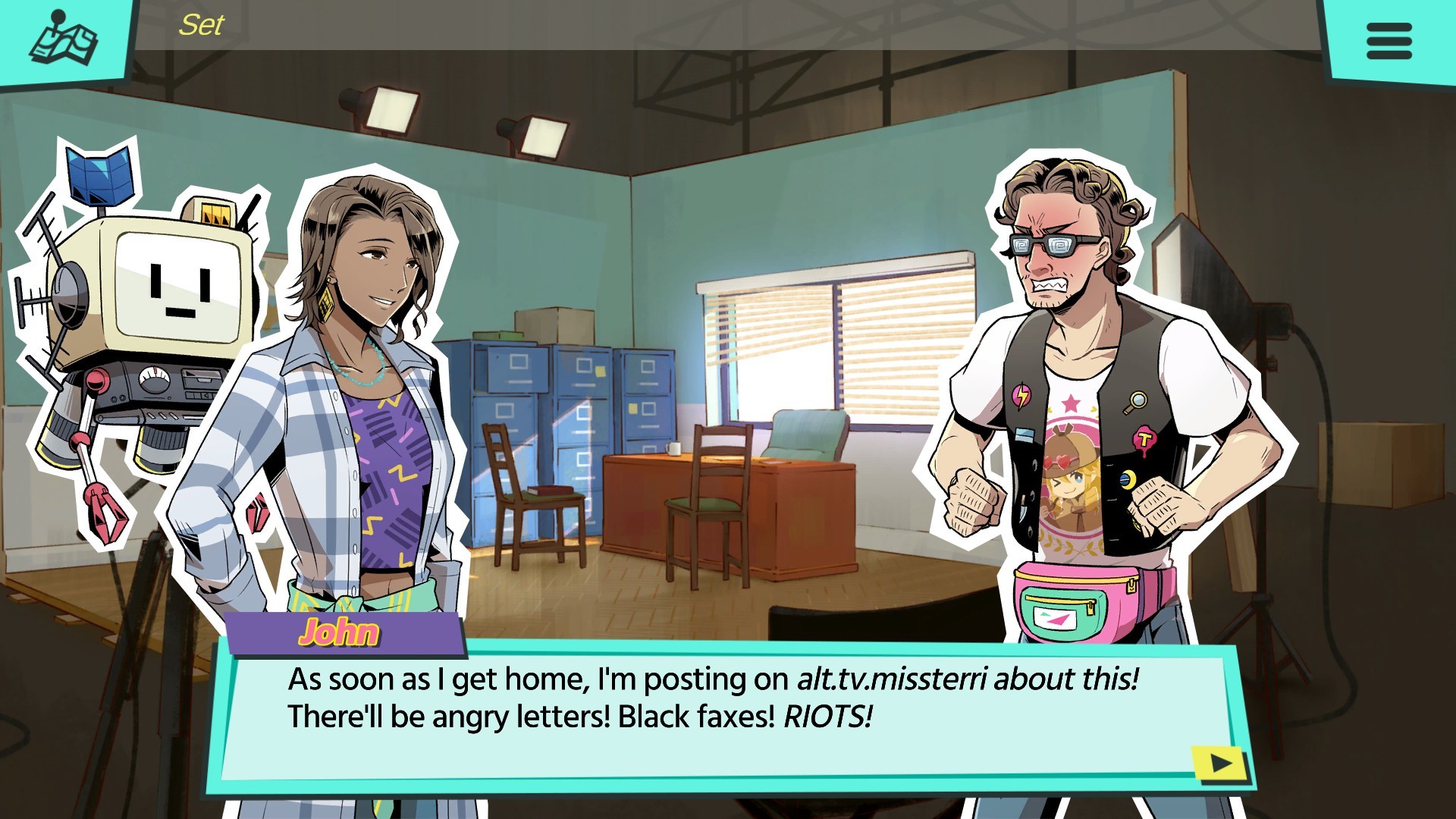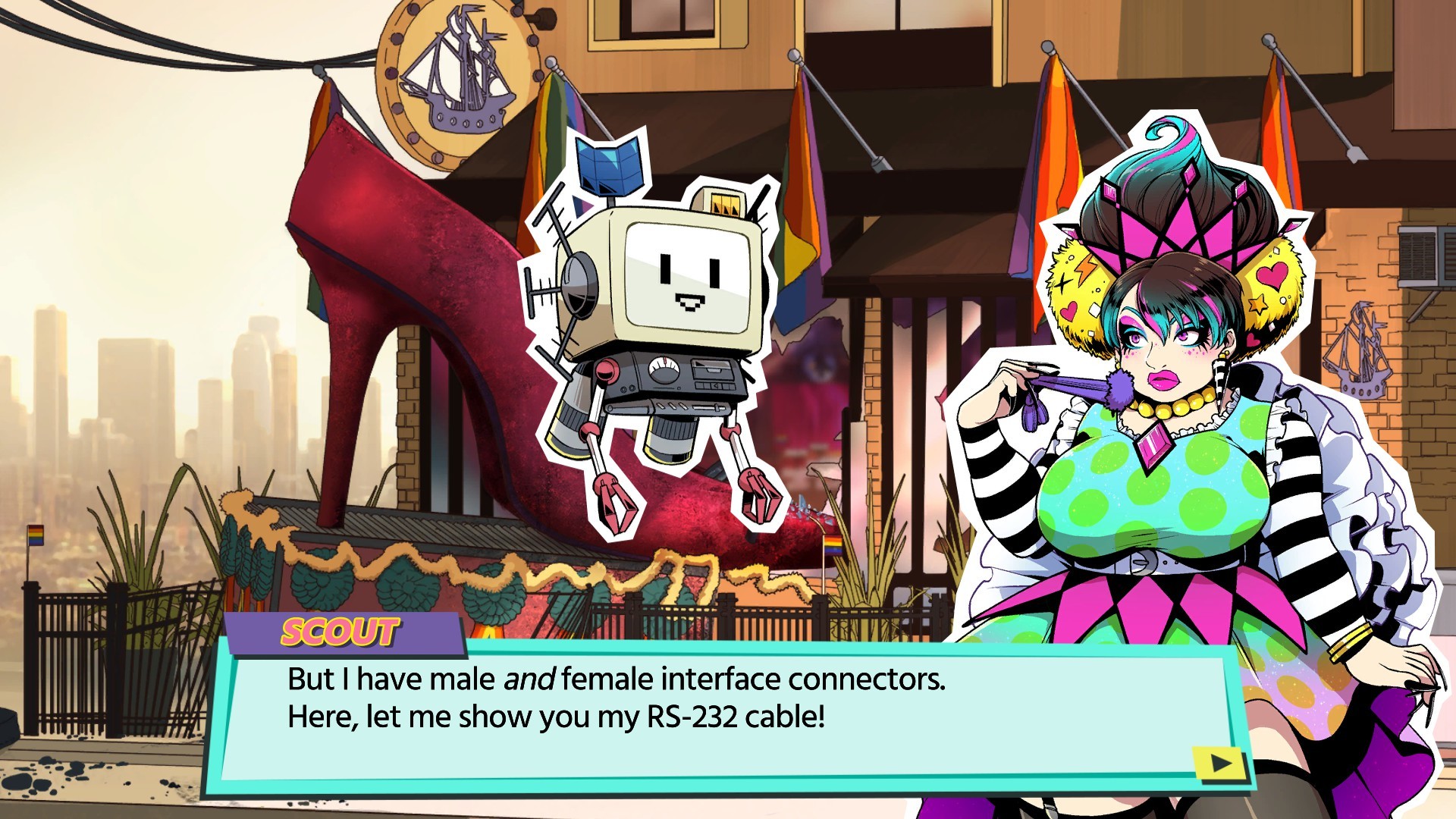Elementary, my dear robot
Murder by Numbers is a murder-mystery visual novel with investigation elements inspired by Phoenix Wright, and punctuated by nonogram puzzles. It even shares some of Ace Attorney's musical pedigree. This... should really be a slam dunk for me. And while I ultimately still liked this detective-story-and-puzzles game, I can't help but obsess over how I might have liked it even more.

Let's start with the good. Murder by Numbers has a slightly-absurd premise - protagonist Honor is an actress playing a detective, assistant SCOUT is a floating robot who really shouldn't exist in the game's 1990s setting - and yet, not unlike the Fey family's insane spiritual powers, strong characterization and scene-setting make it all totally believable. Detective-story tropes are both honored and subverted, Honor's friends have some genuinely interesting qualities, and characters react to each case's tragedies in poignant but believable and sympathetic dialog.
The case stories are engaging and well-structured, for the most part -- a notable exception being the final case, which feels a lot like it should have been two separate cases (especially since the Kino case really deserved a better resolution of its own). But otherwise, the written story of each case is plenty immersive and compelling.
And like some of the best Ace Attorney tales, Murder by Numbers does a good job of blending humor into its narrative.

Unfortunately, the way in which puzzles are blended in leaves something to be desired. What could have been a gameplay mechanic which supports narrative immersion is instead a distraction from the story, and ultimately detracts from it.
An example of how this combination "should" work is in one of the game's first puzzles. You're in a locked room and looking for a way to escape: you go into robot-assisted investigation mode (neat!); the flashing reticle and beeping noises draw you toward a ventilation grate (good so far!); and you complete a nonogram puzzle of the grate to uncover the exit. Pretty slick, right?
Well, this ludonarrative harmony is the exception, not the norm. From there onward, the investigation target is almost never related to the puzzle -- the reticle will converge on a bathroom mirror, and you'll pull out a fire extinguisher; or it'll focus on a featureless section of floor, and a gun will magically appear.
At first these inconsistencies between environment art and puzzle pictures feel like missed opportunities. But as the game goes on, and this discordance continues unabated, it hardens an immersion-breaking wall between story scenes and puzzles. Turning key items into low-resolution puzzle grids is one thing, but when that item doesn't appear in the investigation screen at all, ... what, exactly, is the point of investigating?
It doesn't help that these puzzles become increasingly tiresome in the final case. There are simply too many of them inbetween the later story scenes, and the puzzles themselves start to blend together, as almost all of them are 15x15 grids. (There are one or two 20x15 puzzles at the very end, but otherwise the game gets "stuck" at 15x15 for most of its running length.)
There is one other venue for puzzles in the game's story, in a few instances where SCOUT needs to "hack" something and you must complete a series of small, randomized 5x5 puzzles with a time limit. These segments are a welcome departure from the normal puzzles, and their hectic presentation, along with the time limit, makes completing them actually feel thrilling. But they don't occur very often.
Outside of the story, there's also the Memories section, where - without narrative accompaniment - you can complete puzzles to "repair SCOUT's database." These puzzles are unlocked based on your progress through the story, which works fine for the most part, with one irritating exception: some of the third case's puzzles are missable, consequently limiting the number of Memory unlocks.
The backstory rewards you get for completing these Memory puzzles are also thoroughly underwhelming, but, hey -- more puzzles.
Finally, I'd be remiss - given my recent complaints about Puppy Cross - if I didn't mention that Murder by Numbers has somewhat mediocre input handling of its own. It's nothing so bad as having to wait for irrelevant animations, but click-and-drag doesn't lock to a row or column at all; and there's no undo button, so it's awkwardly easy to drift into marks you've already made and overwrite them by accident.
I don't want to make it sound like I merely tolerated the game's shortcomings. I mean... I kinda did, in the Memory puzzles. But it isn't as if the game's story mode was "bad," hell, the storytelling was actually pretty good! The art is great, the music is catchy, and the puzzles are as functional as they need to be.
The whole package could have been even better, though, with just a bit more attention paid to the narrative-puzzle bridge.
Better than: Professor Layton and the Curious Village, Puppy Cross
Not as good as: Nonogram - The Greatest Painter, Professor Layton vs. Phoenix Wright: Ace Attorney
Not as good as most Ace Attorney games: except for that Edgeworth spin-off and those godawful "Asinine Attorney" DLCs.
Progress: Finished all cases and all memory puzzles.